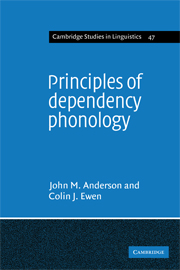Book contents
Overview of Part I
Published online by Cambridge University Press: 04 August 2010
Summary
In Part I we have presented arguments, notably in chapters 1 and 2, in favour of a particular view of phonological structure. In this view, the properties of segmental structure are most adequately characterised if the atomic elements (components) out of which segments are constructed are conceived of as being organised into systematic subsets (gestures) within which particular components may be present or absent and within which components may or may not preponderate over one another. Sequential structure is organised into constituents of a particular kind; they are binary, headed constructions–i.e. each construction has two members, one the (sequentially simplex) head of the construction, the other its (possibly complex) modifier. Headship is manifested in terms of relative prominence.
Chapter 3 provides a characterisation of preponderance and prominence in terms of the binary relation of dependency more familiar from work on syntactic structure. Crucial to the representation of the obligatory constructional layers of tone group, foot, syllable and rhyme is the notion of successive headship for an element, whereby a single element may be head of successively more inclusive constructions. These constructions are unlabelled, even though they are not differentiated in terms of the nature of their head; each differs from that which it immediately includes and that which immediately includes it in terms of direction of modification. The successive headships of a single element are characterised by subjunction paths.
- Type
- Chapter
- Information
- Principles of Dependency Phonology , pp. 137 - 138Publisher: Cambridge University PressPrint publication year: 1987



